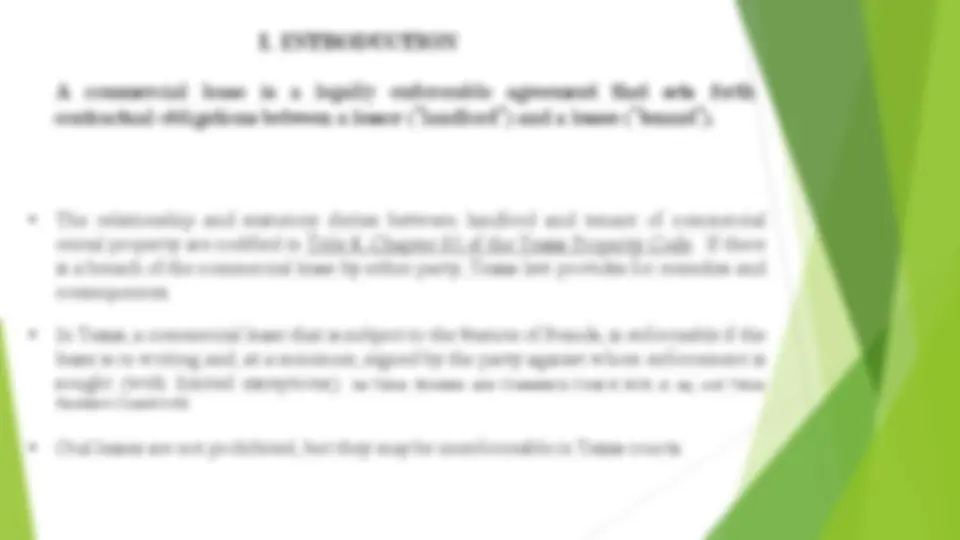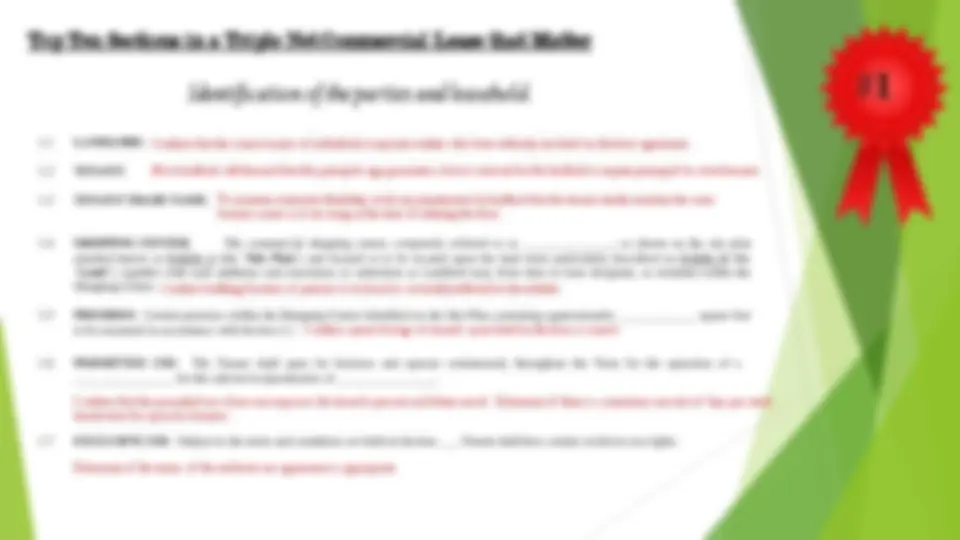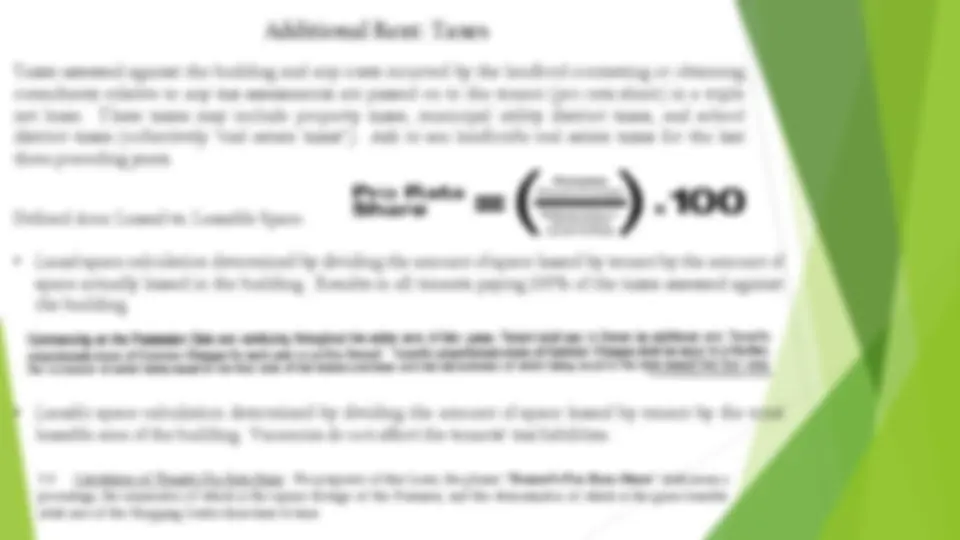
























Study with the several resources on Docsity

Earn points by helping other students or get them with a premium plan


Prepare for your exams
Study with the several resources on Docsity

Earn points to download
Earn points by helping other students or get them with a premium plan
Community
Ask the community for help and clear up your study doubts
Discover the best universities in your country according to Docsity users
Free resources
Download our free guides on studying techniques, anxiety management strategies, and thesis advice from Docsity tutors
The recapture clause allows a landlord to determine whether rent under an assignment or sublease is more favorable than the rent being paid by the current.
Typology: Schemes and Mind Maps
1 / 30

This page cannot be seen from the preview
Don't miss anything!























- Benjamin Franklin
Overview of Presentation
Base Rent The minimum rent due under the terms of a commercial lease that also requires the tenant to pay additional rent based on a percentage of gross sales or a pro rata share other net charges.
Building Owners and Managers Association (BOMA)
BOMA publishes internationally recognized standards for measuring office space on behalf of the commercial real estate industry.
Common Area Maintenance (CAM) An additional rent, charged on top of base rent, and is mainly composed of maintenance fees for work performed on the common area of a property used by more than one tenant. One of the net charges billed to tenants in a commercial triple net (NNN) lease. Examples include parking lot repairs, security, and lighting.
Critical Area (Redlined Area) An area specified by a tenant as critical to its operations. It usually includes all of the climate controlled lease area, a certain portion of parking and sometimes a view corridor to a major street. The critical area is typically identified by outlining it on a site plan of the leased premises. It is sometimes referred to as the “redlined area”.
Cold Shell A commercial building with an unfinished interior and lacking heating, ventilating, and air conditioning (HVAC), and usually without lighting, plumbing, or ceilings.
Continuous Operation Clause A clause requiring that the tenant not cease operations for an extended period of time, usually more than 30 to 90 days.
Co-tenancy Agreement A requirement that the lease terminates if another tenant vacates the shopping center or terminates their lease. Used if majority of traffic to the shopping center is dependent on a major anchor tenant.
Evergreen Leases A lease that includes an option to renew that is automatically exercised at the end of each term unless one party expressly notifies the other that it does not want to continue the lease.
Exclusive Agreement A requirement by a tenant that no other tenants within a particular area, usually a shopping center, cell certain goods or services sold by the tenant requesting the exclusivity.
Go-Dark Clause and Go-Dim Clause Allows tenant to cease operations without default, while still paying rent. A go-dim clause allows a tenant to modify its hours of operation to reduce costs.
Rentable Area Includes space tenant occupies and uses, and an additional allocation of certain areas and other space that are not for the exclusive and effective use of the tenant (i.e. lobbies, hallways).
Recapture Clause A clause allowing a landlord to terminate a tenant’s lease in the event of a request for approval of an assignment or a sublease. The recapture clause allows a landlord to determine whether rent under an assignment or sublease is more favorable than the rent being paid by the current tenant and then terminate the lease to capitalize on an increase in rent.
Subordination, Non-disturbance and Attornment Agreement (SNDA)
An agreement whereby a tenant under a superior lease subordinates its interest in the leased premises to a mortgagee (the subordination agreement) and agrees to recognize the mortgagee or another purchaser at a foreclosure sale as the landlord under the lease in the event of a foreclosure (the attornment agreement) and whereby the mortgagee agrees to maintain all of the rights of the tenant under the lease so long as the tenant is not in default (the non-disturbance agreement). The separate components of the typical SDNA can be mixed and matched together. The critical component for a tenant is the non-disturbance agreement.
Sublease A sublease is a lease between a tenant who already holds a lease to a commercial space and someone (the sublessee) who wants to use part or all of the tenant’s space. In a sublease, the tenant assigns certain rights that they already hold to the leased space, to the sublessee. Sublessees pay rent directly to the rightful tenant (sublessor).
Tenant Improvements Renovations and remodeling done by a tenant to prepare for occupancy of the lease space for its purposes.
Tenant Improvement Allowance Money paid by the landlord to off-set the tenant’s cost of renovating the leased space for its purposes.
Triple Net Lease A lease where the landlord passes through to the tenant and the tenant pays the taxes, operating expenses and insurance on the lease premises. Most common type of general commercial building lease.
Usable area The space tenant occupies and uses exclusively.
1.1 LANDLORD :
1.2 TENANT :
1.3 TENANT TRADE NAME :
1.4 SHOPPING CENTER : The commercial shopping center, commonly referred to as _______________, as shown on the site plan attached hereto as Exhibit A (the " Site Plan ") and located or to be located upon the land more particularly described on Exhibit B (the " Land "), together with such additions and extensions or reductions as Landlord may, from time to time designate, as included within the Shopping Center.
1.5 PREMISES : Certain premises within the Shopping Center identified on the Site Plan containing approximately _____________ square feet to be measured in accordance with Section 2.1.
1.6 PERMITTED USE : The Tenant shall open for business and operate continuously throughout the Term for the operation of a _________________ for the sale/service/production of _________________.
Confirm that the correct names of individuals/corporate entities who have authority are listed on the lease agreement.
Most landlords will demand that the principals sign guarantees, but it is unusual for the landlord to require principals be actual tenants.
To maintain maximum flexibility, avoid any requirement by landlord that the tenant strictly maintain the same business name as it was using at the time of entering the lease.
Confirm building/location of premise to be leased is accurately reflected in the exhibits.
Confirm square footage of tenant’s space listed in the lease is correct.
Confirm that the permitted use clause encompasses the tenant’s present and future needs. Determine if there is a minimum amount of days per week tenant must be open for business.
1.7 EXCLUSIVE USE : Subject to the terms and conditions set forth in Section ___, Tenant shall have certain exclusive use rights.
Determine if the terms of the exclusive use agreement is appropriate.
1.8 LEASE TERM : The Lease Term (sometimes referred to as the " Term ") shall commence on the Commencement Date and shall continue until expiration of the _______ full calendar month thereafter, unless sooner terminated or renewed as provided herein.
1.9 RENEWAL TERM : Subject to the terms and conditions set forth in Section 2.8, Tenant shall have the right to renew the Term for one (1) period of either five (5) years of seven (7) years each
Determine the commencement date. Does it differ from the possession date? If there is a difference, confirm date when the initial lease term and/or rent begins. Confirm if remedies are available to the tenant if the space is not ready by the rent commencement date?
Determine if the tenant has an option to extend the lease beyond the initial term. If so, confirm the number and length of each option term. Is the increase in rent for each option term reasonable? Is the increase in rent based upon a fixed amount, the prevailing market value, or the Consumer Price Index (CPI)? What are the requirements to exercise the option? Make sure that past defaults that are cured by Tenant won’t impede Tenant’s ability to exercise the option. Is the option limited to the original tenant or can it be assigned? Always require that options be exercised in writing and noticed within a specific period. Landlords will try to avoid providing renewal options or strictly limiting those they do give. Tenants should negotiate to have very open options.
21.1 Surrender. At the expiration or termination of this Lease, Tenant shall deliver to Landlord the Premises with all improvements located therein in good repair and condition, broom-clean, reasonable wear and tear excepted, and shall deliver to Landlord all keys to the Premises and all keys to any interior locks. Should any of Tenant's property remain within the Premises after the expiration or termination of this Lease, it shall be deemed abandoned, and Landlord shall have the right to claim from Tenant all expenses arising out of Tenant's failure to remove the property. Tenant waives all claims against Landlord for any damage to Tenant resulting from Landlord’s storing, removing, or disposing of any such property. What are the tenant’s obligations after surrender? Are these obligations reasonable? Determine the termination date of the lease. What are the landlord’s and tenant’s rights to terminate early? Confirm the timeframe for landlord’s obligations to inspect after surrender and to refund the security deposit to tenant. A landlord’s obligations with respect to security deposits of commercial tenants are outlined in Texas Property Code §§ 93.004-93.011. A landlord is presumed to act in bad faith if it fails to return a security deposit or to provide an itemized list of deductions on or before the 60 th^ after the date the tenant surrenders the premises to the landlord. See Texas Property Code § 93.011(d).
Confirm that base rent is calculated correctly. Does the monthly rental payment exceed the fair rental value of the property by a wide margin? Determine if the lease provides for any period of free rent. Has rent for the first and last months of the lease been prorated accordingly if occupancy by tenant is less than a full month? Determine if there is a reasonable grace period and written notice before a late fee is imposed. Is the late fee reasonable?
Time Period Annual Rent/PSF Monthly Rent Annual Rent Months 1-3: $0.00 $0.00 $0. Months 4-15 $20.00 $8,150.00 $97,800. Months 16-27 $21.00 $8,557.50 $102,690. Months 28-39 $22.00 $8,965.00 $107,580. Months 40-51: $23.00 $9,372.50 $112,470. Months 52-63: $24.00 $9,780.00 $117,360.
(a) Commercial General Liability. Bodily Injury, Personal Injury, and Property Damage with the following minimum coverages: General Aggregate (applicable to each location) $1,000,000. Products/Completed Operations Aggregate $1,000,000. Personal and Advertising Injury $1,000,000. Fire Legal Liability $50,000. Medical Payments $5,000.
11.4 Waiver of Subrogation Rights. Landlord and Tenant each waives all rights of recovery, claim, action or cause of action against the other, its agents, officers or employees for any loss or damage that may occur to any person, the Premises or Shopping Center, or any personal property of such party therein, that are caused by or result from risks insured under any insurance policies maintained or required to be maintained by the parties hereto under the terms of this Lease or in force at the time of any such damage, REGARDLESS OF CAUSE OR ORIGIN, INCLUDING NEGLIGENCE OF THE OTHER PARTY HERETO , its licensees and invitees, and covenants that no insurer shall hold any right of subrogation against such other party.